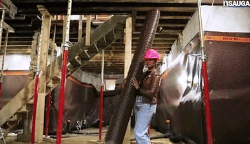Mississauga High School Students Win $20,000 from Samsung
Published March 29, 2016 at 1:38 pm

Students at Gordon Graydon Memorial High School were recently awarded $20,000 from Samsung for being one of eleven national finalists in the Samsung Solve for Tomorrow Challenge.
Even cooler: the very local winners are the only group from Ontario and their project is focused on halting microbead (a plastic product commonly found in cosmetics that makes it way into natural bodies of water) pollution.
The Solve for Tomorrow Challenge seeks to reward students who are proficient in STEM (science, technology, engineering and mathematics) subjects. The initiative — which offers the winning team of a grand prize of $50,000 — was designed to encourage students to get involved in STEM fields (which are, we can all admit, objectively and uniquely challenging). As to how it works, the company will award winning schools across Canada a share of $500,000 in technology products. Also, two grand prize winning schools will be visited by Mitchell Moffitt and Gregory Brown of AsapSCIENCE, who will feature the winning product on their YouTube Channel AsapTHOUGHT.
You can learn more about the contest here.
According to a press release, Gordon Graydon’s team was judged from a pool of 55 semi-finalists based on a video documenting their STEM solution. Now, the $20,000 richer team of young, tech-savvy upstarts will be given an opportunity to participate in the final public voting phase of the contest for a chance to win an even sweeter $50,000 in Samsung tech and some valuable facetime with AsapSCIENCE.
The contest is open to public voting, and you can select your favourite project here until April 18.
As for the project — and this is lofty, so prepare to be impressed — the press release says that “the team proposed a microbead filtration system similar to electrostatic precipitators filtering airbone smoke aerosols. Their model would be located at the final stage of sewage treatment plants which will be retrofitted with negatively charged metal grids that conduct negative charges as microbeads pass through the aqueous solution, giving them a negative charge.
Then, the microbeads pass through a series of positively charged metal plates that attract the negatively charged microbeads. These metal plates are moved over collection bins, and the positive charge is disabled in order for the microbeads to be collected.”
[video:https://youtu.be/380nfprnL6s]In layman’s terms, the microbeads will be contained and no longer make their way into the Great Lakes, halting microbead pollution.
Not to gloss over the social value of the project, the students met with local MPs and other community leaders to discuss the government’s position on microbeads and microplate pollution. The students are chiefly interested in discussing how Mississauga — and the city’s youth in particular — can clean the Great Lakes and ban microbeads. The young team has also met with researchers and Environmental Defense representatives to discuss the organization’s Ban the Bead campaign and summer lake clean up.
“A group of students came together and decided we wanted to take our classroom learning and apply it to solve a real life problem,” explains a Gordon Graydon team representative in a press release. “We chose to investigate microbeads. Microbeads are tiny plastics that are micrometres in diameter which are used in cosmetics, exfoliating agents, and hygiene products and make up twenty percent of the plastic pollution in the Great Lakes.”
insauga's Editorial Standards and Policies advertising





